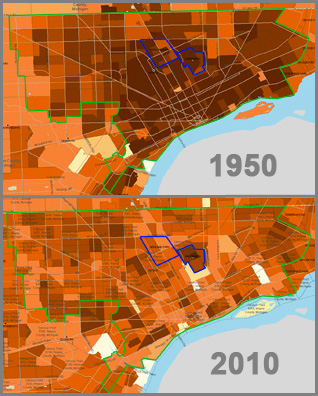Squandered opportunities leave Detroit isolated
During this period, there was significant segregation within the city itself, Sugrue said, with some neighborhoods being entirely white and others entirely black. “The city failed numerous times to build affordable housing in white neighborhoods,” he said. “There was extremely strong neighborhood resistance to that.”
Recognizing that segregation was also extremely prevalent in Detroit’s school system, and that largely black schools performed much more poorly than largely white schools, the Detroit Board of Education passed an order in 1970 that would have bused white children to black schools, and vice-versa. A locally based recall campaign followed, and the state passed a law that voided the plan and kept school districts under neighborhood control.
Later that year, the NAACP sued the state and the school board in federal District Court, arguing that, as in Brown v. Board of Education, separate was not equal, and that the policies of the state and school board had deliberately kept the school system segregated. The case was entitled Milliken v. Bradley.
The district court found in favor of the NAACP and ordered the school district to draft a desegregation plan. The city presented the court with three different Detroit-wide plans, all of which the court rejected. The court then ruled that it was not possible to desegregate the Detroit Public School System without including the suburban communities. The city was ordered to submit a “metropolitan” plan that would eventually encompass a total of fifty-four separate school districts, busing Detroit children to suburban schools and suburban children into Detroit.
On appeal, however, the Supreme Court ruled against the NAACP. Even though the organization had presented evidence of housing segregation that operated on a metropolitan level, Chief Justice William Burger claimed that “the case does not present any question concerning possible state housing violations,” and Justice Potter Stewart, who cast the key fifth vote dooming a metropolitan remedy, asserted that housing segregation was caused by “unknown and unknowable causes.”
The impact of the case was enormous. According to Gary Orfield and Susan E. Eaton in their 1996 book Dismantling Desegregation, “By failing to examine housing, the Court gave neighborhoods that had successfully segregated their housing an exemption from school desegregation requirements. City neighborhoods that had not excluded, blacks, on the other hand, faced mandatory desegregation.” The court effectively blessed suburbs with all-white schools as “refuges for whites fearful of minorities moving into their schools,” Orfield and Eaton wrote.
More generally, according to Dismantling Desegregation, the “Supreme Court’s failure to examine the housing underpinnings of metropolitan segregation” in Milliken made desegregation “almost impossible” in northern metropolitan areas. “Suburbs were protected from desegregation by the courts ignoring the origin of their racially segregated housing patterns.”
A “hopeless” problem?
“Milliken was perhaps the greatest missed opportunity of that period,” said Myron Orfield, professor of law and director of the Institute on Race and Poverty at the University of Minnesota (the brother of UCLA’s Gary Orfield). “Had that gone the other way, it would have opened the door to fixing nearly all of Detroit’s current problems.”
Population density plummets
Map & Data Resources
See how the population density of Detroit has changed over the last 60 years.
Orfield said that had the region’s school districts been successfully desegregated, it would also have put pressure on officials to open up housing opportunities to African American families in the suburbs. “Housing segregation and school segregation are intimately linked,” he said. “Where you have one you always have the other.” (See maps of segregation in Detroit over time.)
It is also likely, had the metropolitan remedy gone into effect, that the white flight out of the city would have been much less severe, according to Mogk. Mogk served briefly on the school board at the time, and he urged the NAACP to include the suburbs in its initial complaint, which the NAACP declined to do. When the suburbs were ultimately insulated from the remedy, the busing plan only took effect inside the city lines, making it possible for white families to avoid sending their children to largely black schools simply by moving to a nearby suburb.
“Everybody thinks that it was the riots [in 1967] that caused the white families to leave,” he said. “Some people were leaving at that time but, really, it was after Milliken that you saw mass flight to the suburbs.”
Mogk said that if the case had gone the other way, it is likely that Detroit would not have experienced the steep decline in its tax base that has occurred since then.
“When you have big areas that are largely poor, that’s the last place that new businesses usually invest,” Myron Orfield added. “It’s also impossible to have a functioning school district in a very poor city, which has made it much harder for Detroit to attract new residents.”
Several experts agreed that the intense segregation of the region is a primary cause of Detroit’s structural problems. Additionally, Orfield said, once a region is less segregated, it becomes easier to implement other regional policies because racial resistance is not as strong.
“After that, you had a hardening of positions, making it much harder to get anything else done,” he said. “A deeply segregated city is kind of a hopeless problem. It becomes more and more troubled and there are fewer and fewer solutions.”

